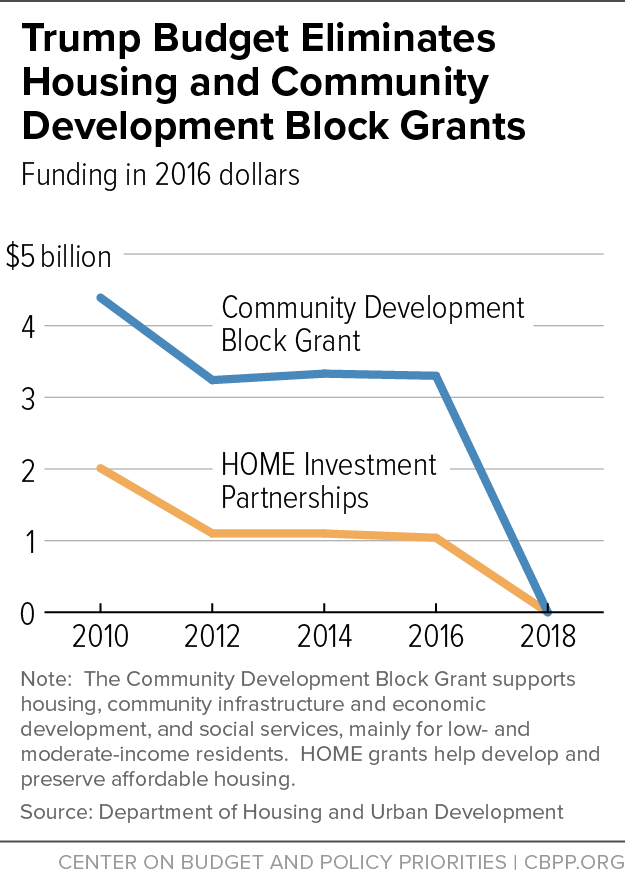BEYOND THE NUMBERS
The President’s 2018 budget for the Department of Housing and Urban Development (HUD) proposes the sweeping elimination of flexible programs that states and localities use to rehabilitate and build affordable rental housing, repair and improve infrastructure such as sewers and roads, promote economic development in distressed communities, and provide essential services to low-income youth, seniors, and others. Taken together, these proposals would effectively abandon the longstanding federal role in strengthening low- and moderate-income communities.
Specifically, the budget would eliminate:
- HOME Investment Partnerships. In 2017, HOME will provide $950 million in grants to help states and localities develop or rehabilitate affordable homes for low-income households. HOME is a critical source of financing for developing affordable rental housing, including supportive housing for homeless people with disabilities. And it has contributed to the creation of nearly 500,000 affordable rental units since its inception in 1990. Communities also use HOME funds to provide counseling for first-time homebuyers and help low-income seniors and other homeowners to repair their homes. (See the table below for the estimated HOME cuts by state and jurisdiction.)
- Community Development Block Grant. CDBG, funded at $3 billion in 2017, provides highly flexible funds that communities use to develop affordable housing, repair and upgrade basic infrastructure such as sewers and streets, promote commercial redevelopment in distressed areas, and provide life-enriching services such as recreational services for youth, employment training for adults, and center- and home-based services for seniors. Nearly 1,300 states, cities, towns, and counties in urban, suburban, and rural areas receive CDBG funds, which are allocated based on need. Program rules require that part of the funds primarily benefit low-income households. (See the table below for the estimated CDBG cuts by state and jurisdiction.)
- Choice Neighborhoods Initiative (CNI). Funded at $138 million in 2017, housing authorities and their partners use CNI funds primarily to rehabilitate public and other assisted housing and surrounding distressed communities.
- National Housing Trust Fund. States use the fund, which is supported by contributions from Fannie Mae and Freddie Mac, to develop affordable rental housing, particularly for households with extremely low incomes. HUD allocated $174 million to states for this purpose in 2016.
Overall, the budget would eliminate $4.3 billion in flexible resources and, for the two largest programs — HOME and CDBG — these cuts would follow years of decline (see chart). Moreover, local losses would likely far exceed $4.3 billion, as communities typically leverage these federal dollars to secure additional public and private resources. For instance, every $1 in HOME funds typically raises another $4 for development, according to the National Council of State Housing Agencies.
The Administration defends its proposals by arguing that states and localities are “better positioned” to address local housing and community development needs. Yet many states and localities lack the resources to meet those needs — particularly the low- and moderate-income communities in which most of these funds are used and where economies are weak, tax bases may be inadequate, and state governments may be unwilling or unable to help, making federal resources essential.
The Administration also argues that CDBG is poorly targeted to communities in need and cites “challenges to measuring the program’s impact.” But, as the budget itself concedes, the latter is a direct result of the program’s essential flexibility: communities use the funds in highly diffuse ways depending on local priorities, making their impact much harder to assess. And, while reforms to improve CDBG targeting are worth discussing, eliminating the program would harm the neediest communities, not help them.
| TABLE 1 | |
|---|---|
| Potential Impact of Selected Trump Budget Proposals in 2018, by Jurisdiction |
|
| State | Estimated Cut in 2018 |

